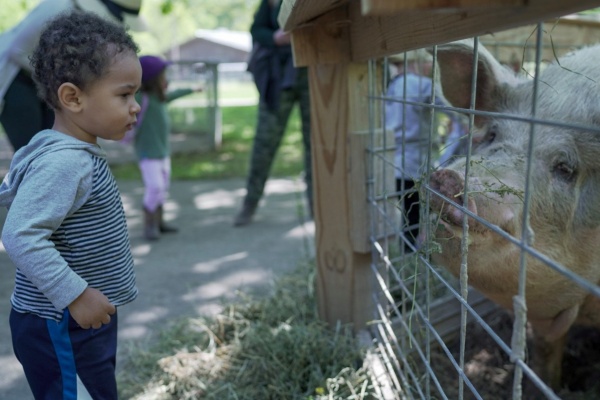

Super High SPF? Spray vs. Lotion? Organic vs. Traditional? Your Complete Guide to Kids' Sun Safety
The long, hot days of summer are in full swing, which means kids are spending hours outdoors in the sun swimming, playing sports, attending camps and other activities. Being active outside is great, but it's important to make sure kids are adequately protected against the harmful rays of the sun. Carrie Coughlin, MD, a Washington University pediatric dermatologist with Siteman Kids at St. Louis Children's Hospital, helps provide some guidelines and address confusion and concerns many parents have about proper sun care.
A trip down the sunscreen aisle at any drug or discount store offers a confounding array of choices and SPF (sun protection factor) numbers, and much has been written and debated about the effectiveness of various SPF levels.
"SPF 15 is supposed to filter about 93 percent of UVB rays, SPF 30 gives you up to about 97 percent filtering out of UVB rays and SPF 50 is about 98 percent; so you can see that the incremental increase in protection above SPF 50 is small," says Dr. Coughlin. "Even doubling going from SPF 50 to SPF 100 only gets you about two percent more coverage; so once you get above a SPF 30 or 50, the difference is minimal."
It's also confusing to grasp the difference between a sunscreen and a sun block. According to Dr. Coughlin, the key is to select one that is broad spectrum – meaning it blocks both UVB and UVA rays. UVB rays are the ones that make you more tan, while UVA rays pose a higher risk for causing skin cancers, so you really want to prevent both from damaging the skin. The difference between a screen and a block comes down to ingredients.
Chemical sunscreens include ingredients like avobenzone and oxybenzone that must be on the skin for 15 to 30 minutes before going outside in order to be effective. Physical sun blocks contain zinc oxide or titanium dioxide, which sit on the top layer of the skin and protect it as soon as they are applied.
"I don't think you can always predict when you're exiting the house, so if you know it works as soon as you put on the sun block, it's a lot easier," says Dr. Coughlin. "They do take a bit more effort to rub in, but a lot of the formulations now rub in a bit better than they used to."
As for the debate on using sunscreens that are labeled "organic" or "natural" versus traditional store brands, she says, "I look more at the ingredients than the branding. If you've got a zinc- or titanium-based product, that's what I look for, as opposed to looking at if they are organic or not. A lot of people use the word 'natural' with regards to skin products, but there are a lot of natural ingredients that can also irritate your skin and some of the manufactured ingredients can actually be gentler."
And what about those convenient spray-on sunscreens versus lotion? Sprays can make for easier and quicker application, but may not be providing the coverage you need and should never be used on or near the face.
"We definitely recommend you don't spray sunscreen on the face because you're just asking to inhale particles. You can spray them on other parts of the body, but you do need to spray on enough to have to rub it in to ensure that you have complete coverage," Dr. Coughlin says. "If you're doing a sweep with the spray but not rubbing it in, you can imagine that those little particles are settling down and there will be areas of the skin that aren't actually covered. By the time you spray on enough to rub it in, you've used a lot of spray, which can be expensive, and you still have to do the work of rubbing it in. For some areas that are trickier like the scalp, sprays are good because it's hard to get a lotion into a part-line; but I tend to just get a lotion with zinc and titanium, SPF at least 30, and go with that."
Other things to consider with regard to sun care are sunscreen reapplication and limiting overall exposure. The sun's rays are strongest between the hours of 10 a.m. and 4 p.m., so exposure during those hours should be limited with frequent breaks in the shade or indoors. Protective clothing like SPF swim shirts, shorts and hats can also help limit the surface area of skin being exposed. General sunscreen protection lasts about two hours in activity when people are not wet or sweaty. If you're wet or sweaty, you need to reapply about every 80 or 90 minutes.
"Even one burn increases your risk for skin cancer down the line, so ideally, you don't ever get burned," Dr. Coughlin says.
Infants and newborns have their own specific set of recommendations when it comes to sun exposure and care. According to the American Academy of Pediatrics, once an infant is six months old, you can apply sunscreen like you would with any other child. "For infants under six months, ideally you're doing a lot of the clothing, hats and shading them from the sun; but you are allowed to use some sunscreen on areas you just can't keep covered up like the backs of hands and cheeks," says Dr. Couglin.
Moles are common in children, and while most moles are benign (not cancerous), melanoma, a type of skin cancer, sometimes forms from or within a mole. Siteman Kids at St. Louis Children’s Hospital offers the Pediatric Melanoma and Nevus Clinic to address the diagnosis and treatment of atypical moles or skin cancer that can affect children’s health. Its team includes physicians in dermatology, pediatric oncology, plastic surgery, pediatric surgery, and pediatric otolaryngology (ENT) with support of radiology, dermatopathology, and genetics.
In addition to treating children, the Pediatric Melanoma and Nevus Clinic helps to advance clinical and scientific knowledge about these conditions through participation in databases and clinical trials. Clinics are held twice monthly on Thursdays at St. Louis Children’s Hospital Specialty Care Clinic in west St. Louis County.

Amy Burger is a mom, freelance writer and communications professional with nearly 20 years experience working in St. Louis. Her work has appeared in numerous publications and media outlets including STL Parent, Missouri Life magazine, the St. Louis Post-Dispatch, Town & Style and kdhx.org, among others. When she's not working, she enjoys spending time with her husband and two beautiful girls at home in Kirkwood.




















